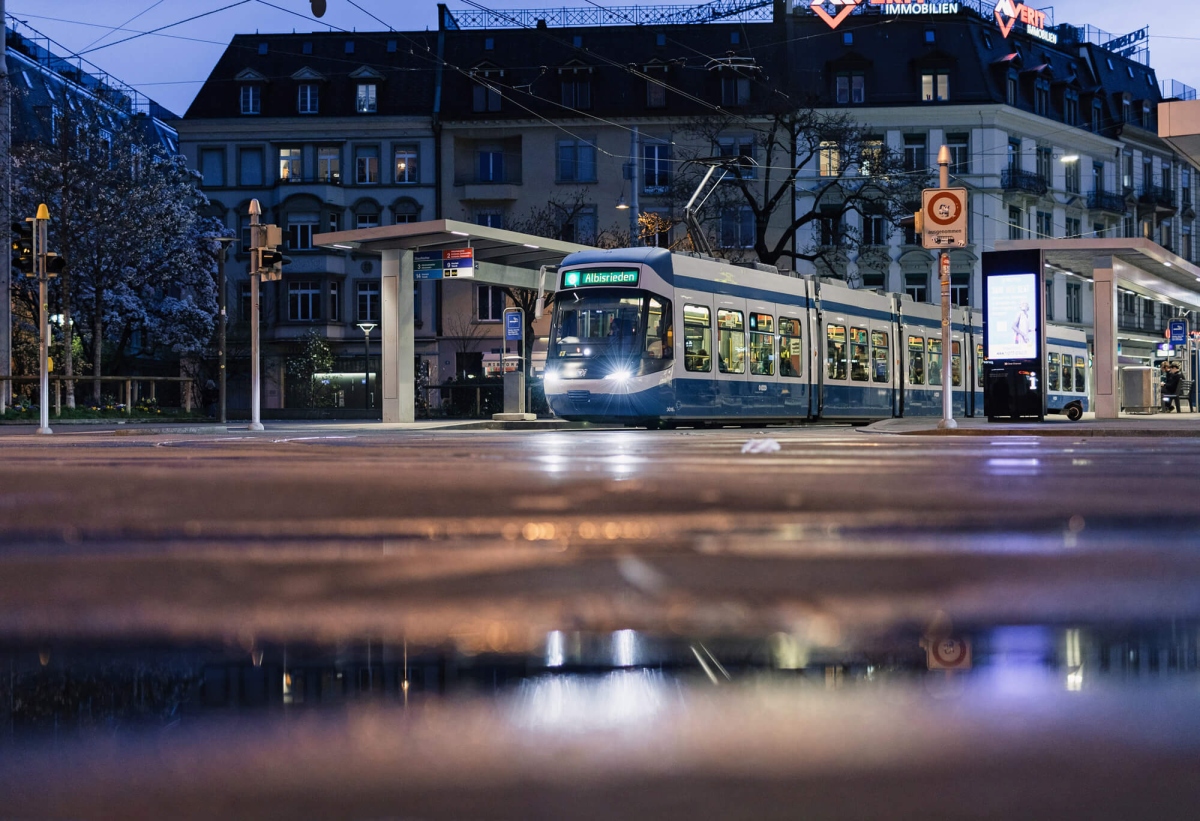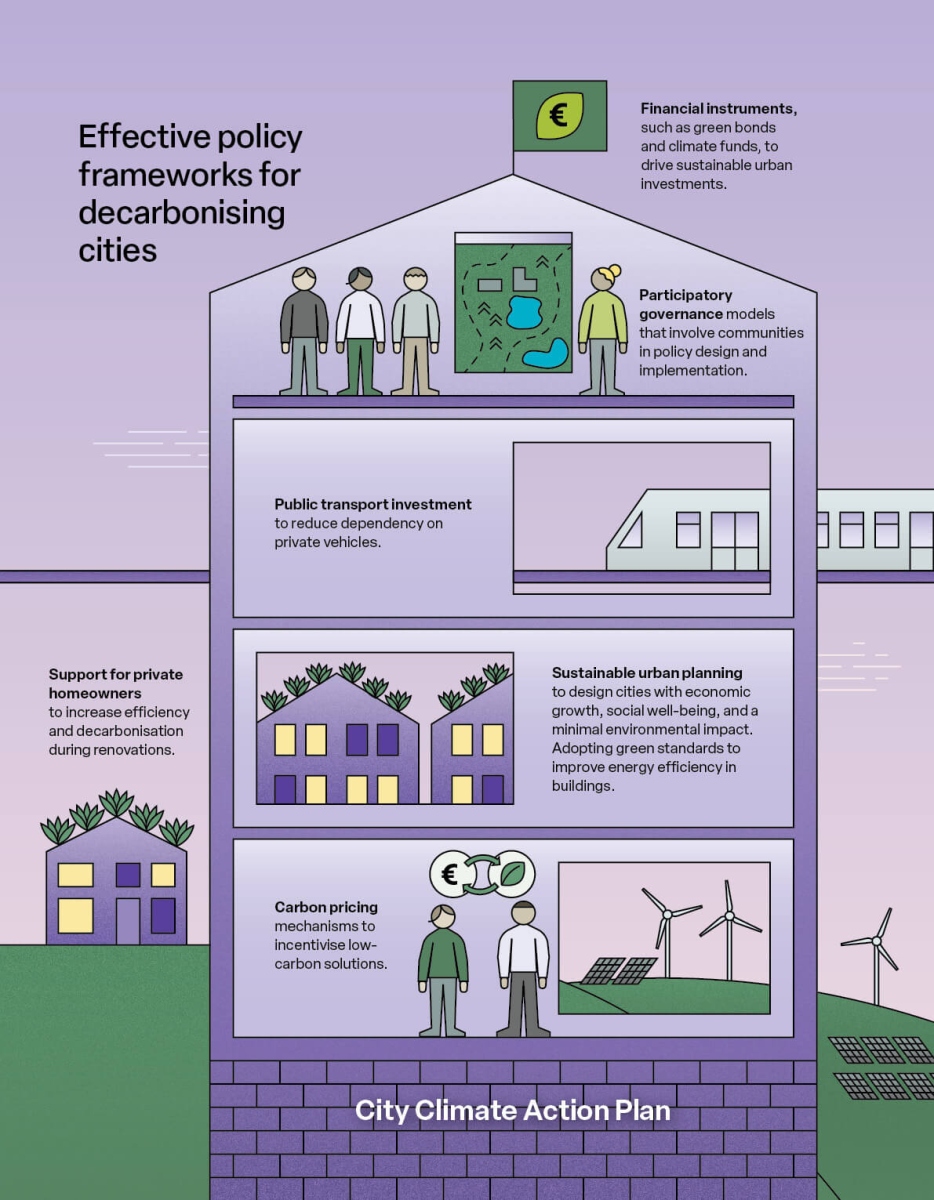
Decarbonising cities is not just about reducing emissions: it is about building healthier communities, robust economies, and increasing climate resilience. This requires a fundamental reimagining of urban planning, transport, energy systems, and green spaces.
Key takeaways
- Urban decarbonisation brings many benefits. Decarbonising cities is not only about cutting emissions, but also improving public health, strengthening economies, and building climate resilience.
- Effective decarbonisation requires a holistic approach. Cities must integrate solutions across key sectors, including transport, buildings, and green spaces, to achieve their climate goals.
- Policy, finance, and public engagement are crucial for success. While many solutions are available, implementing them requires strong political will, smart funding, and citizen buy-in.
Cities are hotspots for emissions, making urban climate action critical to meet the European Union's goal of cutting net emissions by 55% by 2030 and reaching climate neutrality by 2050.
Many EU cities are taking steps to become more sustainable places to live and work, with city authorities producing climate action plans to chart a path to climate neutrality and build their resilience to global warming.
These plans aim to keep cities on track with the global goal to limit warming to 1.5°C above pre-industrial levels. They underscore the need for rapid change, particularly in wealthy cities.
“Achieving climate goals requires integrated urban planning, sustainable transport, energy efficiency, and nature-based solutions, all supported by strong governance and finance mechanisms,” says Professor Bart van den Hurk, Co-Chair at the IPCC Working Group II on impacts, adaptation, and vulnerability.

Urban areas are major sources of greenhouse gas emissions. Reducing their reliance on fossil fuels and choosing sustainable solutions not only addresses this but also brings many other benefits for cities.
Illustration: Bassi Mattsson
Decarbonising transport
Beyond simply getting people from A to B, efficient and accessible transport systems are fundamental enablers of freedom, opportunity, and connection. Improving access to sustainable mobility not only reduces the carbon emissions of a city but also improves public health and wellbeing by decreasing air pollution.
“Switching to clean transport options can have a significant impact on greenhouse gas emissions, reducing them by 55% to 94% with policies and technologies that are already available,” says Jens Mueller, Deputy Director at Clean Cities, who worked on a study1 that modelled policy scenarios in Brussels, Madrid, Greater Manchester, Milan, and Warsaw.
Switching to clean transport options can have a significant impact on greenhouse gas emissions, reducing them by 55% to 94% .
Jens Mueller, Deputy Director at Clean Cities
Measures include improving public transport, switching to low-carbon fuels, increasing cycle lanes and pedestrian zones, and discouraging people from using private cars, particularly those running on fossil fuels.
To ensure its transport sector is zero-emission by 2030, Amsterdam is combining vehicle electrification with cycling, public transport, low-emission zones for diesel vehicles, and zero-emission zones for vans, lorries, mopeds, and scooters.
Meanwhile, Oslo aims to have a zero-emission public transport system by 2028 and has redesigned its city centre for walking and cycling. London has expanded its ultra-low emission zones, which discourages the most polluting vehicles from entering the city, and Paris has introduced low-emission zones, pedestrianised major roads along the Seine, and expanded cycling infrastructure.
“These measures are replicable with the right political will, investment, and public engagement. Success very much depends on tailoring policies to local conditions and ensuring public transport and active travel alternatives are accessible,” says Mueller.
The effectiveness of different policies varies between cities. Northern European cities have made rapid progress by prioritising a shift to cycling and public transport, while Southern and Eastern European cities often have higher car dependency, making measures like public transport electrification, bus lanes, and low-emission zones more important, Mueller adds.
“Investments in walking and cycling infrastructure can deliver rapid change at limited costs in almost any city, as demonstrated by cities like Barcelona, Ljubljana, or Wrocław,” he says.
Decarbonising transport is not just key to reducing urban emissions and improving health, but also for ensuring compliance with progressively tightening EU regulations in this sector. For example, the EU plans to phase out sales of new combustion engine cars by 2035 and will introduce a carbon price on road transport fuel in 2027, which is likely to increase the cost of petrol and diesel for consumers.
Reducing emissions from buildings
Another significant source of urban emissions is the construction and energy consumption of buildings.
More than 85%2 of Europe’s existing building stock is likely to still be in use in 2050, the deadline for the EU to achieve climate neutrality. However, almost 75% of Europe’s buildings are energy inefficient and the share of renewables in heating and cooling was only 26% in 2023.3 Fossil fuels still dominate household heating and are expected to remain a large part of it up to 2030 and potentially beyond.4
Almost 75% of Europe’s buildings are energy inefficient and the share of renewables in heating and cooling was only 26% in 2023.
Eurostat 2025
A major renovation drive is required to improve energy efficiency, decarbonise heating and cooling systems, and prepare buildings for future heat stress or flooding.
The type of work required depends on the city’s climate and building stock. For example, to address its ageing, inefficient building stock, the Estonian capital of Tallinn has started a renovation project to revamp apartment buildings and create inclusive, sustainable spaces, like courtyards. Its city-owned buildings are also transitioning to local, clean, and efficient district heating, which will be expanded to include apartment buildings.
In Italy, Milan is developing a social housing project that aims to be zero-carbon by 2050. It will include buildings that use energy, heating, and cooling from renewable sources. The project also aims to have 60% of the surrounding area designated as green space and an emphasis on green mobility, including a 1,200 m2 bike garage, 10 electric car charging terminals, and a shared neighbourhood car fleet.
Meanwhile, the Hungarian city of Szeged is taking advantage of the country’s abundant geothermal resources by switching its gas-fuelled district heating system to this renewable energy source. Szetav, the city’s district heating provider, and currently the largest local CO2 emitter, estimates the switch could reduce its emissions by 60%.
EU legislation is being implemented to support building decarbonisation. For example, under the EU’s energy efficiency law, public buildings are required to undergo renovation at a rate of 3% per year. Municipalities with over 45,000 inhabitants must also prepare local heating and cooling plans. Meanwhile, a new EU law on buildings requires countries to renovate the 16% worst-performing buildings by 2030.
The EU additionally plans to introduce carbon pricing for building heating in 2027 and to phase out fossil fuel boilers by 2040, which makes cities’s decarbonisation efforts essential.

Nature as part of the solution
Green urban areas, including parks, forests, and gardens, have wide-ranging benefits for cities, including carbon sequestration, temperature regulation, improved well-being, and habitats for biodiversity. Less research has been conducted on the impact of blue urban areas, such as rivers and lakes, but these can also help capture carbon,5 improve flood resilience, and regulate temperatures.6
“On a city level, green areas take up 4–10% of urban emissions and this is likely to increase as human-caused emissions reduce,” says Professor Leena Järvi at the University of Helsinki.
Professor Järvi’s research shows that all green areas matter. For example, in Nordic cities, urban lawns are likely to absorb between 30–50% of what a boreal forest would.
“Traditionally, people think that urban forests are those places where carbon sequestration takes place. However, our research shows that actually the built vegetation, so street trees, lawns, or any kind of green area, is also important in absorbing CO2,” says Professor Järvi.
Street trees, lawns, or any kind of green area, are also important in absorbing CO₂.
Professor Leena Järvi, University of Helsinki
Preserving existing green spaces should also be a core focus as it can take time for new ones to reach a point where they act as a carbon sink, she says.
Challenges also exist when it comes to fitting green areas into cities where space is already restricted.
“Limitations include space constraints in dense urban areas, high initial costs, and the need for long-term maintenance and governance frameworks to ensure effectiveness,” says Professor van den Hurk.
Another challenge is that green areas like gardens tend to be privately owned, limiting what local authorities can do. On top of this, what is considered an ‘ideal garden’ is not always the most beneficial for carbon sequestration and biodiversity.
“The current trend is that you have a beautiful, wide lawn and maybe a few trees. Messy looking green areas, which are probably best for taking up carbon dioxide, for biodiversity, and any of the co-benefits, are not seen as appealing,” says Professor Järvi, adding that this requires a mindset change and campaigns to promote the benefits of this style of garden.
Good planning is also needed, including considering what trees best suit a city and allowing sufficient space for roots and branches to avoid damaging infrastructure, like buildings and tram lines.
Cities will also need to work on this to comply with new EU laws. Under the Nature Restoration Law, EU countries must maintain or increase urban green space and canopy cover by 2030 unless existing coverage is already substantial. By 2031, they should increase total national urban green space, including integrating this into buildings and infrastructure.

Challenges and opportunities ahead
Although climate action is urgently needed and has the potential to improve cities, implementing it is a challenging task. The European Commission’s Joint Research Centre warns of insufficient community engagement and low public awareness, alongside inconsistencies between local policies and national and EU strategies. There are also challenges around upscaling cleaner technologies and bridging regional disparities.
Professor Van den Hurk emphasises the importance of inclusiveness in the decarbonisation process:
“Equitable access requires policies that promote affordability, subsidies for low-income communities, open-access data platforms, and capacity-building programmes to enhance technology adoption in developing regions.”
Money is available for this, including direct funding through the EU’s Mission for Climate-Neutral and Smart Cities, the European Urban Initiative, and the EU’s LIFE programme. The European Investment Bank’s framework loans also help cities to boost clean energy and adapt to climate change. Alongside this, the bank runs an advisory platform to help adaptation in urban areas.
The benefits of natural infrastructure
By Kira Taylor
Nature-based solutions are crucial for cities to achieve their carbon neutrality targets, but the effectiveness depends on careful integration into city planning.
City planning is an immensely complex task, and in every city, there are different economic, geographic, cultural, and political challenges to be considered.
Nature-based solutions are often considered ‘a nice-to-have’ and used as an add-on to other climate action strategies.
However, nature-based solutions can actually be very effective in reducing net emissions when implemented correctly, according to a recent, award-winning scientific study.7
“Cities can quantify the impact of nature-based solutions on reducing greenhouse gas emissions and identify the locations where different types of nature-based solutions would be most effective,” says the scientific team lead, Professor Zahra Kalantari at KTH, the Swedish Royal Institute of Technology.
Quantifying benefits in this way is an important step in integrating nature-based solutions into climate plans, particularly as it can help secure policy backing and economic support.
It is very important to involve a multidisciplinary team of experts when designing nature-based solutions to maximise their effectiveness.
“In particular, it is often beneficial to engage local stakeholders and be guided by their knowledge so that the solutions achieve the desired benefits and avoid unexpected downsides,” says Professor Kalantari.
Technical aspects can be designed by experts or engineers, similar to traditional ‘grey’ infrastructure. However, they will need support from specialists in local botany or ecology to select the right plants.
“When designing solutions, cities must consider the entire socio-ecological system and how it will function and be maintained,” Professor Kalantari concludes.

City-to-city insights
By Charlotta Henry
Many cities have innovative climate programmes to encourage behavioural changes.
- Can you share one innovative policy or programme your city is using to cut emissions?
- How is your city encouraging behavioural changes and what has been most effective?

1. Helsinki has introduced a binding whole-life carbon limit value for new residential apartment buildings. This ensures that at the planning stage, both the operational emissions and also the construction-related emissions are constrained.
2. One initiative is the ‘Think Sustainably’ service, which ranks local businesses like cafés, restaurants and shops by sustainability criteria, enabling customers to choose greener options. This both increases awareness and gives businesses incentives to improve.
Another effective tool has been the ‘transport climate panel’, where a randomly selected group of citizens weigh in on how to transition to zero-emission transport in a way that’s fair and practical. This helps align policy with what people are actually willing and able to do.

1. The City of Zurich supports startups and non-profit organisations in implementing innovative approaches to climate protection with a programme called KlimUp. We also bring stakeholders together in the Klimaforum, a dialogue platform for businesses, experts, and city representatives to develop solutions for climate protection.
The City of Zurich is investing around 2.3 billion Swiss francs in the expansion of the renewable district heating supply to replace gas and oil heating systems.
2. Zurich offers citizens funding programmes for heating replacement, operational optimisation, and energy-efficient building renovations. For companies and institutions, we have a toolbox for reducing emissions, such as those from flights.

1. We have subsidy programmes for residents or companies to support green measures. We give support for building green roofs, greening courtyards, using public transport, and so on. We also offer environmental education and awareness for schools.
2. We organise local energy and climate days, such as the ‘Earth Day’ and ‘Let the climate in Brno be great’. We cooperate with local companies and organise events to support sustainable measures, e.g., events dedicated to energy saving, Environmental, Social, and Governance issues, or carbon storage in wooden buildings.
References
1 Clean Cities: (E)Mission Zero: Towards zero-emission mobility in European cities, 2024
2 European Environment Agency, 2024
3 Eurostat, 2025
4 Statista, 2025
5 Nordic Council of Ministers: Enhancing Carbon Storage through Green and Blue Infrastructure, 2024
6 L. Fricke, R. Legg, N. Kabisch: Impact of blue spaces on the urban microclimate in different climate zones, daytimes and seasons – A systematic review, Urban Forestry & Urban Greening, Vol 101, 2024.
7 Pan, H., Page, J., Shi, R. et al. Contribution of prioritized urban nature-based solutions allocation to carbon neutrality. Nat. Clim. Chang. 13, 862–870 (2023)
